Fundamentals of Accounting II: Case Studies and Depreciation Methods
VerifiedAdded on 2023/06/03
|11
|1795
|124
AI Summary
This article covers case studies and depreciation methods for Fundamentals of Accounting II course. It includes topics such as purchase price, straight-line method, diminishing balance method, sum of year digit method, and units of production method.
Contribute Materials
Your contribution can guide someone’s learning journey. Share your
documents today.
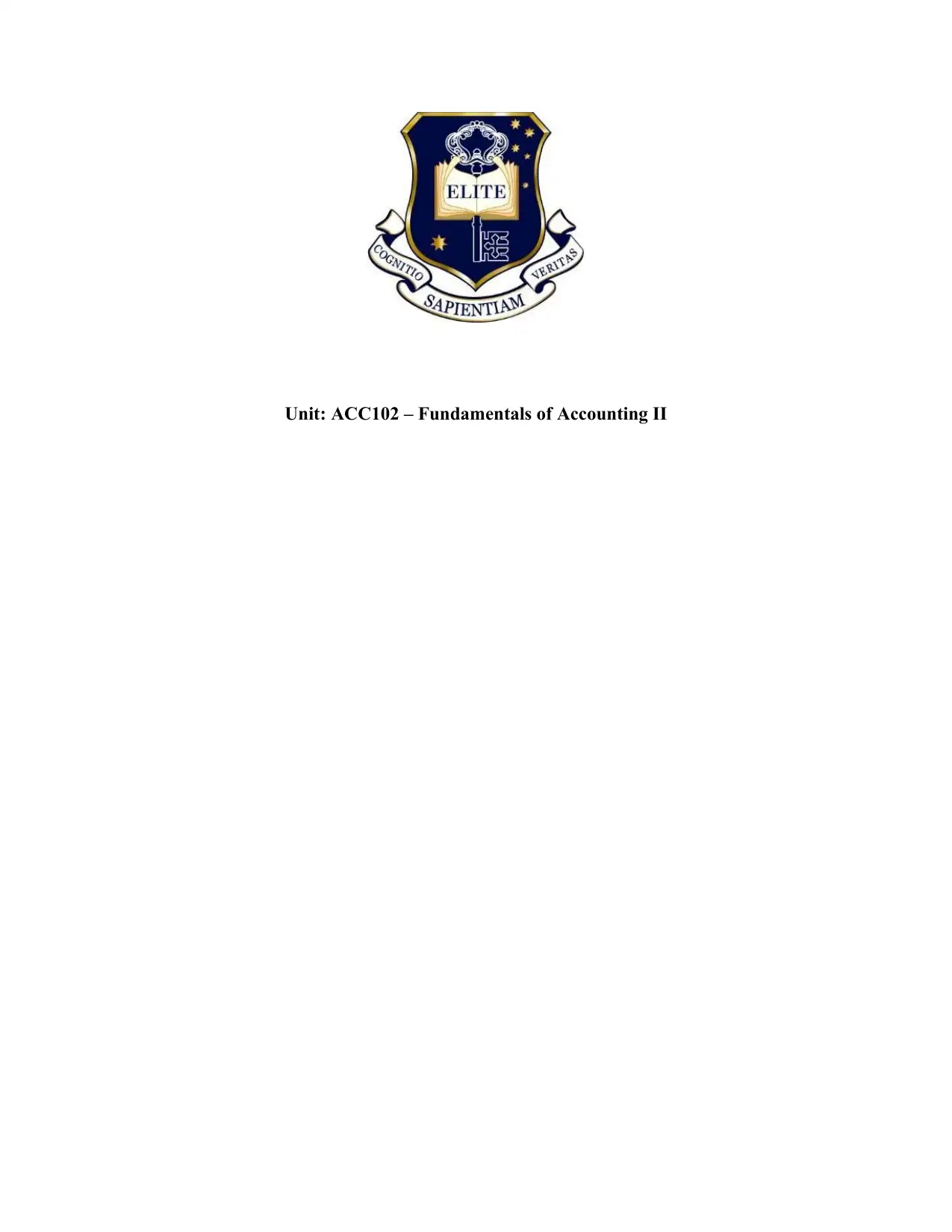
Unit: ACC102 – Fundamentals of Accounting II
Secure Best Marks with AI Grader
Need help grading? Try our AI Grader for instant feedback on your assignments.
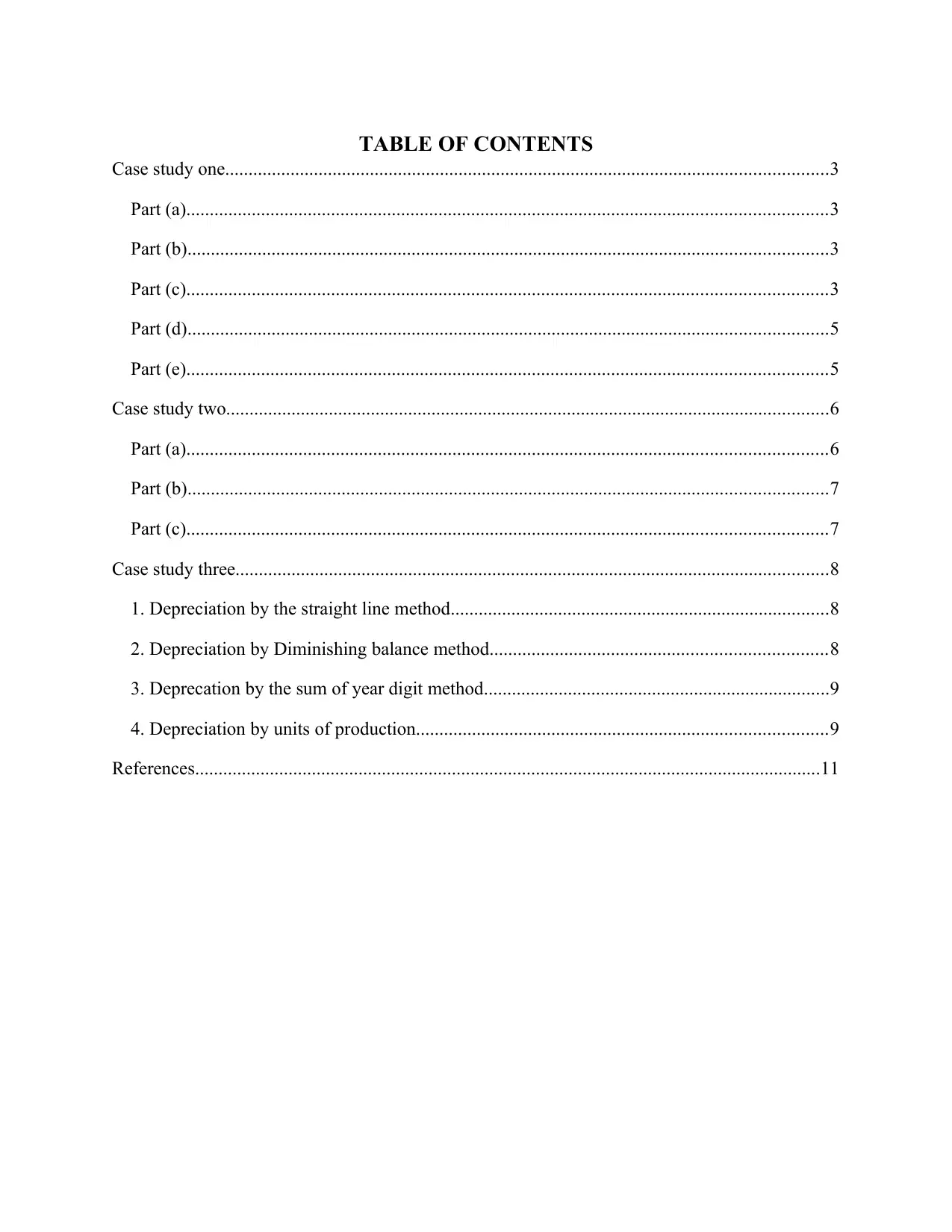
TABLE OF CONTENTS
Case study one.................................................................................................................................3
Part (a).........................................................................................................................................3
Part (b).........................................................................................................................................3
Part (c).........................................................................................................................................3
Part (d).........................................................................................................................................5
Part (e).........................................................................................................................................5
Case study two.................................................................................................................................6
Part (a).........................................................................................................................................6
Part (b).........................................................................................................................................7
Part (c).........................................................................................................................................7
Case study three...............................................................................................................................8
1. Depreciation by the straight line method.................................................................................8
2. Depreciation by Diminishing balance method........................................................................8
3. Deprecation by the sum of year digit method..........................................................................9
4. Depreciation by units of production........................................................................................9
References......................................................................................................................................11
Case study one.................................................................................................................................3
Part (a).........................................................................................................................................3
Part (b).........................................................................................................................................3
Part (c).........................................................................................................................................3
Part (d).........................................................................................................................................5
Part (e).........................................................................................................................................5
Case study two.................................................................................................................................6
Part (a).........................................................................................................................................6
Part (b).........................................................................................................................................7
Part (c).........................................................................................................................................7
Case study three...............................................................................................................................8
1. Depreciation by the straight line method.................................................................................8
2. Depreciation by Diminishing balance method........................................................................8
3. Deprecation by the sum of year digit method..........................................................................9
4. Depreciation by units of production........................................................................................9
References......................................................................................................................................11
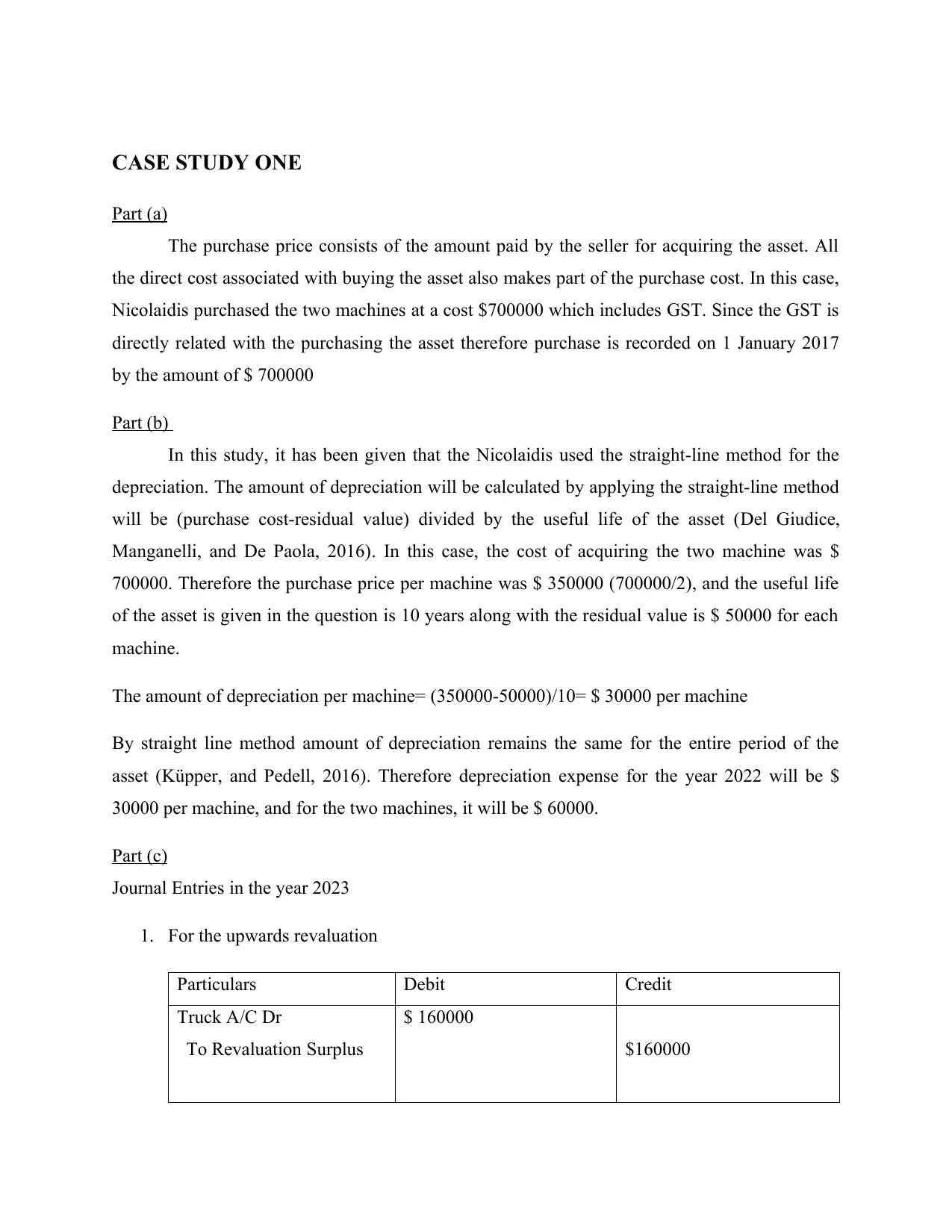
CASE STUDY ONE
Part (a)
The purchase price consists of the amount paid by the seller for acquiring the asset. All
the direct cost associated with buying the asset also makes part of the purchase cost. In this case,
Nicolaidis purchased the two machines at a cost $700000 which includes GST. Since the GST is
directly related with the purchasing the asset therefore purchase is recorded on 1 January 2017
by the amount of $ 700000
Part (b)
In this study, it has been given that the Nicolaidis used the straight-line method for the
depreciation. The amount of depreciation will be calculated by applying the straight-line method
will be (purchase cost-residual value) divided by the useful life of the asset (Del Giudice,
Manganelli, and De Paola, 2016). In this case, the cost of acquiring the two machine was $
700000. Therefore the purchase price per machine was $ 350000 (700000/2), and the useful life
of the asset is given in the question is 10 years along with the residual value is $ 50000 for each
machine.
The amount of depreciation per machine= (350000-50000)/10= $ 30000 per machine
By straight line method amount of depreciation remains the same for the entire period of the
asset (Küpper, and Pedell, 2016). Therefore depreciation expense for the year 2022 will be $
30000 per machine, and for the two machines, it will be $ 60000.
Part (c)
Journal Entries in the year 2023
1. For the upwards revaluation
Particulars Debit Credit
Truck A/C Dr
To Revaluation Surplus
$ 160000
$160000
Part (a)
The purchase price consists of the amount paid by the seller for acquiring the asset. All
the direct cost associated with buying the asset also makes part of the purchase cost. In this case,
Nicolaidis purchased the two machines at a cost $700000 which includes GST. Since the GST is
directly related with the purchasing the asset therefore purchase is recorded on 1 January 2017
by the amount of $ 700000
Part (b)
In this study, it has been given that the Nicolaidis used the straight-line method for the
depreciation. The amount of depreciation will be calculated by applying the straight-line method
will be (purchase cost-residual value) divided by the useful life of the asset (Del Giudice,
Manganelli, and De Paola, 2016). In this case, the cost of acquiring the two machine was $
700000. Therefore the purchase price per machine was $ 350000 (700000/2), and the useful life
of the asset is given in the question is 10 years along with the residual value is $ 50000 for each
machine.
The amount of depreciation per machine= (350000-50000)/10= $ 30000 per machine
By straight line method amount of depreciation remains the same for the entire period of the
asset (Küpper, and Pedell, 2016). Therefore depreciation expense for the year 2022 will be $
30000 per machine, and for the two machines, it will be $ 60000.
Part (c)
Journal Entries in the year 2023
1. For the upwards revaluation
Particulars Debit Credit
Truck A/C Dr
To Revaluation Surplus
$ 160000
$160000
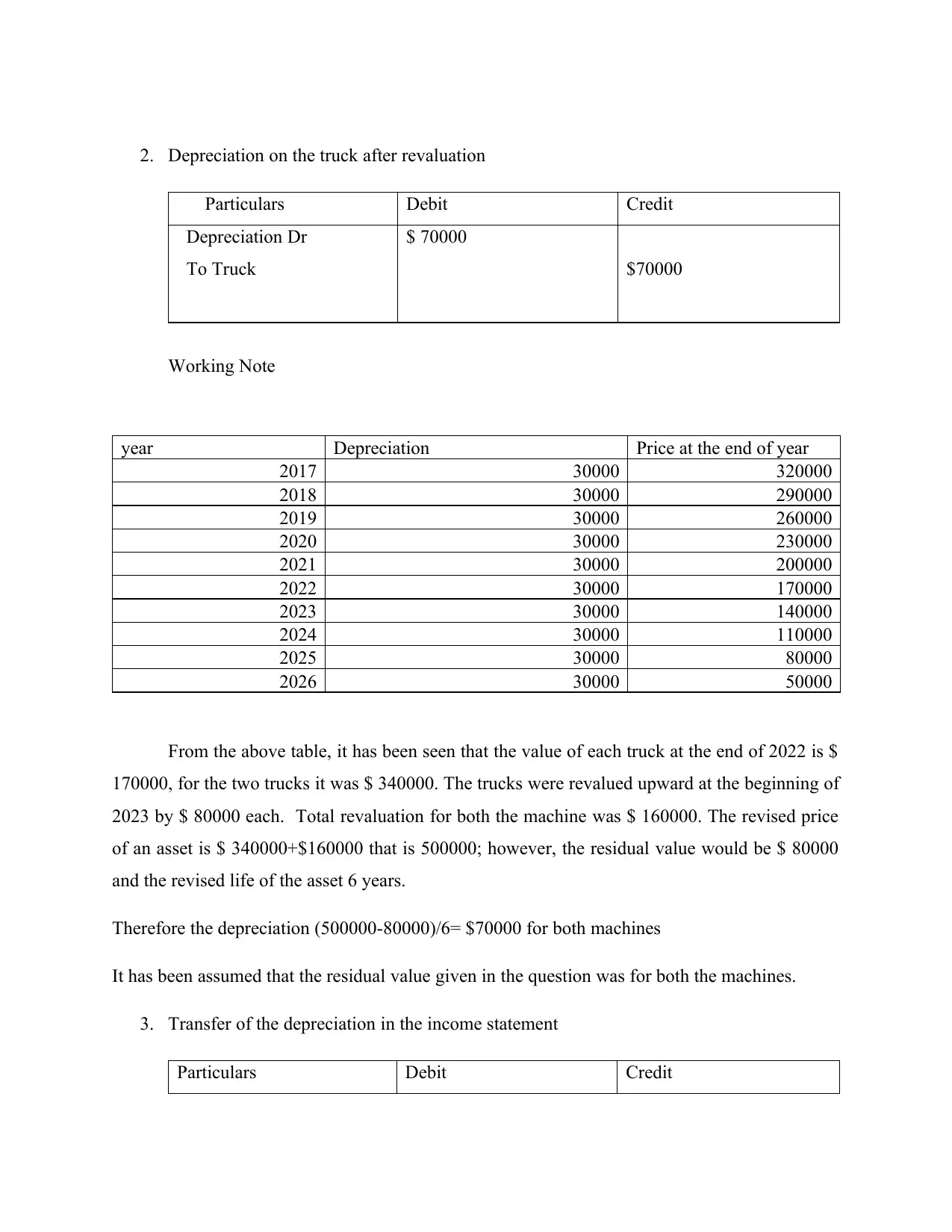
2. Depreciation on the truck after revaluation
Particulars Debit Credit
Depreciation Dr
To Truck
$ 70000
$70000
Working Note
year Depreciation Price at the end of year
2017 30000 320000
2018 30000 290000
2019 30000 260000
2020 30000 230000
2021 30000 200000
2022 30000 170000
2023 30000 140000
2024 30000 110000
2025 30000 80000
2026 30000 50000
From the above table, it has been seen that the value of each truck at the end of 2022 is $
170000, for the two trucks it was $ 340000. The trucks were revalued upward at the beginning of
2023 by $ 80000 each. Total revaluation for both the machine was $ 160000. The revised price
of an asset is $ 340000+$160000 that is 500000; however, the residual value would be $ 80000
and the revised life of the asset 6 years.
Therefore the depreciation (500000-80000)/6= $70000 for both machines
It has been assumed that the residual value given in the question was for both the machines.
3. Transfer of the depreciation in the income statement
Particulars Debit Credit
Particulars Debit Credit
Depreciation Dr
To Truck
$ 70000
$70000
Working Note
year Depreciation Price at the end of year
2017 30000 320000
2018 30000 290000
2019 30000 260000
2020 30000 230000
2021 30000 200000
2022 30000 170000
2023 30000 140000
2024 30000 110000
2025 30000 80000
2026 30000 50000
From the above table, it has been seen that the value of each truck at the end of 2022 is $
170000, for the two trucks it was $ 340000. The trucks were revalued upward at the beginning of
2023 by $ 80000 each. Total revaluation for both the machine was $ 160000. The revised price
of an asset is $ 340000+$160000 that is 500000; however, the residual value would be $ 80000
and the revised life of the asset 6 years.
Therefore the depreciation (500000-80000)/6= $70000 for both machines
It has been assumed that the residual value given in the question was for both the machines.
3. Transfer of the depreciation in the income statement
Particulars Debit Credit
Secure Best Marks with AI Grader
Need help grading? Try our AI Grader for instant feedback on your assignments.
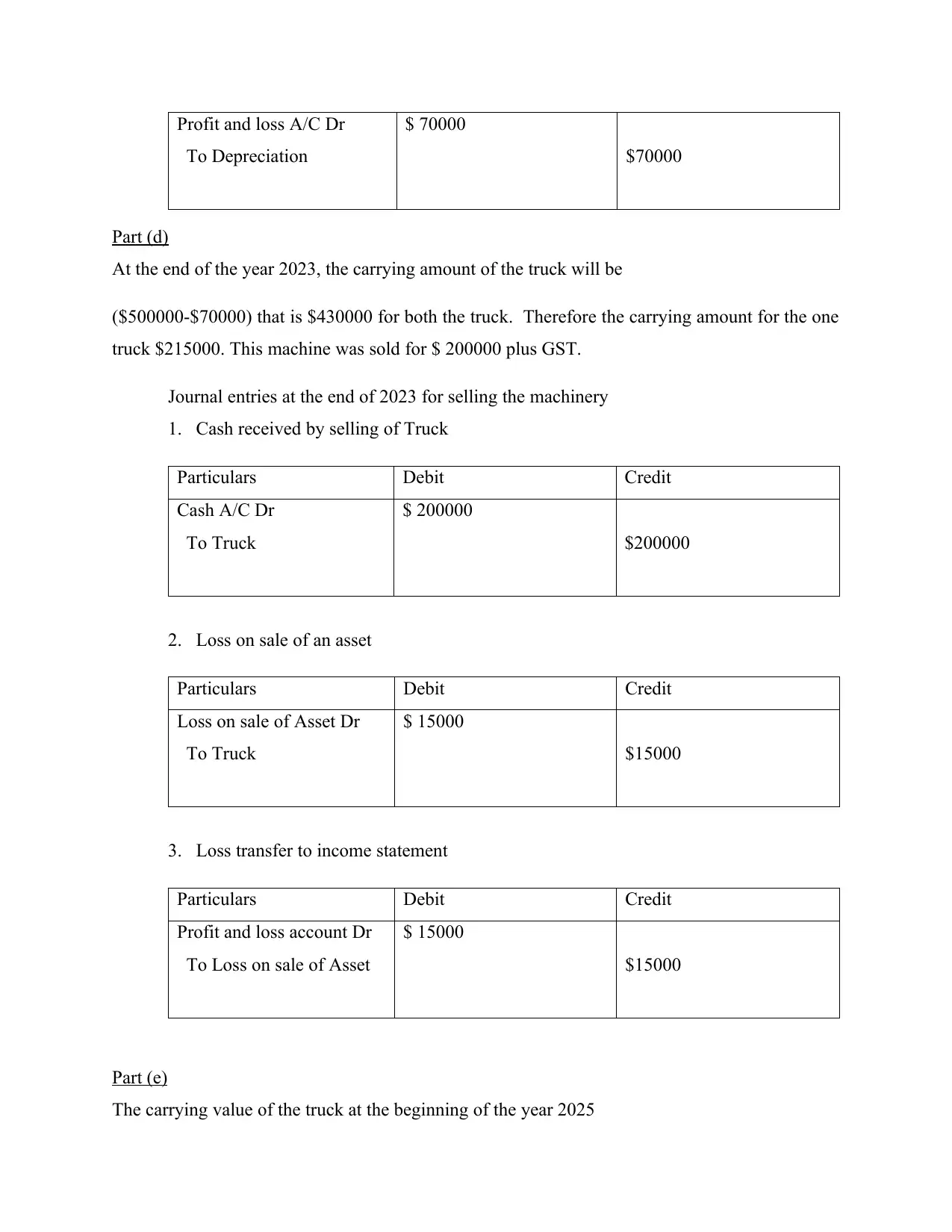
Profit and loss A/C Dr
To Depreciation
$ 70000
$70000
Part (d)
At the end of the year 2023, the carrying amount of the truck will be
($500000-$70000) that is $430000 for both the truck. Therefore the carrying amount for the one
truck $215000. This machine was sold for $ 200000 plus GST.
Journal entries at the end of 2023 for selling the machinery
1. Cash received by selling of Truck
Particulars Debit Credit
Cash A/C Dr
To Truck
$ 200000
$200000
2. Loss on sale of an asset
Particulars Debit Credit
Loss on sale of Asset Dr
To Truck
$ 15000
$15000
3. Loss transfer to income statement
Particulars Debit Credit
Profit and loss account Dr
To Loss on sale of Asset
$ 15000
$15000
Part (e)
The carrying value of the truck at the beginning of the year 2025
To Depreciation
$ 70000
$70000
Part (d)
At the end of the year 2023, the carrying amount of the truck will be
($500000-$70000) that is $430000 for both the truck. Therefore the carrying amount for the one
truck $215000. This machine was sold for $ 200000 plus GST.
Journal entries at the end of 2023 for selling the machinery
1. Cash received by selling of Truck
Particulars Debit Credit
Cash A/C Dr
To Truck
$ 200000
$200000
2. Loss on sale of an asset
Particulars Debit Credit
Loss on sale of Asset Dr
To Truck
$ 15000
$15000
3. Loss transfer to income statement
Particulars Debit Credit
Profit and loss account Dr
To Loss on sale of Asset
$ 15000
$15000
Part (e)
The carrying value of the truck at the beginning of the year 2025

year
Depreciatio
n
Price at
the end
of year
Revaluatio
n
Revise
d value
Revise
d
useful
life
Revised
depreciatio
n
revised
price at the
year end
2017 30000 320000
2018 30000 290000
2019 30000 260000
2020 30000 230000
2021 30000 200000
2022 30000 170000 80000 250000 250000
2023 30000 140000 2023 35000 215000
2024 30000 110000 2024 35000 180000
2025 30000 80000 2025
2026 30000 50000 2026
2027
2028
From the above table, it has been seen that the carrying value of the truck at the beginning of the
year 2025 is $ 180000. If the residual value is $ 50000, then the depreciation will be recorded at
(180000-50000)/4 that is $ 32500. Since the remaining useful life of truck from the year, 2025
was 4 years.
CASE STUDY TWO
Part (a)
Purchase Journal
Date Account Credited Amount
4-June Creditor 10350 (4600*2.25)
12-June Creditor 9840 (4100*2.4)
26-June Creditor 7750 (3100*2.5)
Sales Journal
Date Account Debited Amount
9-June Debtor 20500 (4100*5)
21-June Debtor 15500(3100*5)
24-June Debtor 14500(2900*5)
Depreciatio
n
Price at
the end
of year
Revaluatio
n
Revise
d value
Revise
d
useful
life
Revised
depreciatio
n
revised
price at the
year end
2017 30000 320000
2018 30000 290000
2019 30000 260000
2020 30000 230000
2021 30000 200000
2022 30000 170000 80000 250000 250000
2023 30000 140000 2023 35000 215000
2024 30000 110000 2024 35000 180000
2025 30000 80000 2025
2026 30000 50000 2026
2027
2028
From the above table, it has been seen that the carrying value of the truck at the beginning of the
year 2025 is $ 180000. If the residual value is $ 50000, then the depreciation will be recorded at
(180000-50000)/4 that is $ 32500. Since the remaining useful life of truck from the year, 2025
was 4 years.
CASE STUDY TWO
Part (a)
Purchase Journal
Date Account Credited Amount
4-June Creditor 10350 (4600*2.25)
12-June Creditor 9840 (4100*2.4)
26-June Creditor 7750 (3100*2.5)
Sales Journal
Date Account Debited Amount
9-June Debtor 20500 (4100*5)
21-June Debtor 15500(3100*5)
24-June Debtor 14500(2900*5)
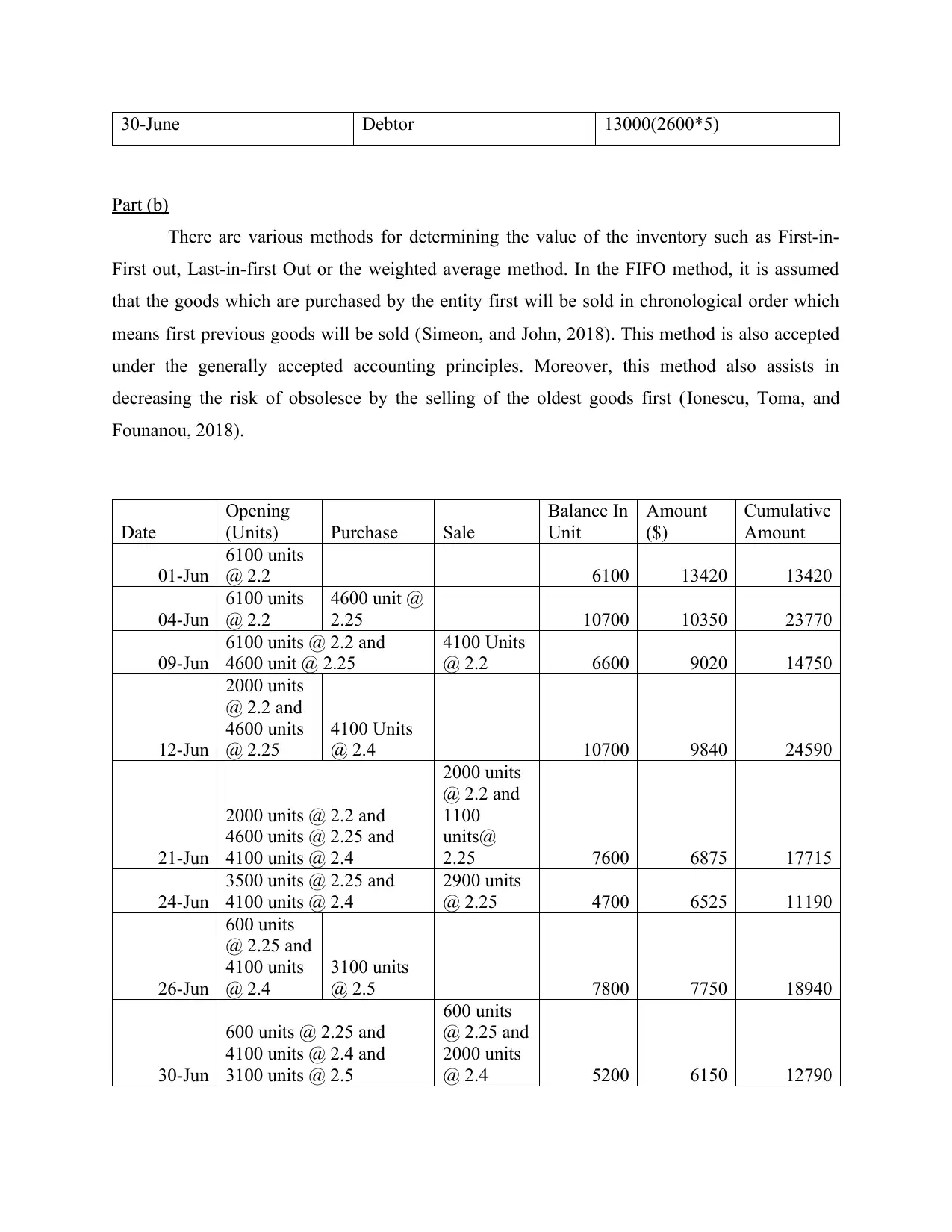
30-June Debtor 13000(2600*5)
Part (b)
There are various methods for determining the value of the inventory such as First-in-
First out, Last-in-first Out or the weighted average method. In the FIFO method, it is assumed
that the goods which are purchased by the entity first will be sold in chronological order which
means first previous goods will be sold (Simeon, and John, 2018). This method is also accepted
under the generally accepted accounting principles. Moreover, this method also assists in
decreasing the risk of obsolesce by the selling of the oldest goods first (Ionescu, Toma, and
Founanou, 2018).
Date
Opening
(Units) Purchase Sale
Balance In
Unit
Amount
($)
Cumulative
Amount
01-Jun
6100 units
@ 2.2 6100 13420 13420
04-Jun
6100 units
@ 2.2
4600 unit @
2.25 10700 10350 23770
09-Jun
6100 units @ 2.2 and
4600 unit @ 2.25
4100 Units
@ 2.2 6600 9020 14750
12-Jun
2000 units
@ 2.2 and
4600 units
@ 2.25
4100 Units
@ 2.4 10700 9840 24590
21-Jun
2000 units @ 2.2 and
4600 units @ 2.25 and
4100 units @ 2.4
2000 units
@ 2.2 and
1100
units@
2.25 7600 6875 17715
24-Jun
3500 units @ 2.25 and
4100 units @ 2.4
2900 units
@ 2.25 4700 6525 11190
26-Jun
600 units
@ 2.25 and
4100 units
@ 2.4
3100 units
@ 2.5 7800 7750 18940
30-Jun
600 units @ 2.25 and
4100 units @ 2.4 and
3100 units @ 2.5
600 units
@ 2.25 and
2000 units
@ 2.4 5200 6150 12790
Part (b)
There are various methods for determining the value of the inventory such as First-in-
First out, Last-in-first Out or the weighted average method. In the FIFO method, it is assumed
that the goods which are purchased by the entity first will be sold in chronological order which
means first previous goods will be sold (Simeon, and John, 2018). This method is also accepted
under the generally accepted accounting principles. Moreover, this method also assists in
decreasing the risk of obsolesce by the selling of the oldest goods first (Ionescu, Toma, and
Founanou, 2018).
Date
Opening
(Units) Purchase Sale
Balance In
Unit
Amount
($)
Cumulative
Amount
01-Jun
6100 units
@ 2.2 6100 13420 13420
04-Jun
6100 units
@ 2.2
4600 unit @
2.25 10700 10350 23770
09-Jun
6100 units @ 2.2 and
4600 unit @ 2.25
4100 Units
@ 2.2 6600 9020 14750
12-Jun
2000 units
@ 2.2 and
4600 units
@ 2.25
4100 Units
@ 2.4 10700 9840 24590
21-Jun
2000 units @ 2.2 and
4600 units @ 2.25 and
4100 units @ 2.4
2000 units
@ 2.2 and
1100
units@
2.25 7600 6875 17715
24-Jun
3500 units @ 2.25 and
4100 units @ 2.4
2900 units
@ 2.25 4700 6525 11190
26-Jun
600 units
@ 2.25 and
4100 units
@ 2.4
3100 units
@ 2.5 7800 7750 18940
30-Jun
600 units @ 2.25 and
4100 units @ 2.4 and
3100 units @ 2.5
600 units
@ 2.25 and
2000 units
@ 2.4 5200 6150 12790
Paraphrase This Document
Need a fresh take? Get an instant paraphrase of this document with our AI Paraphraser
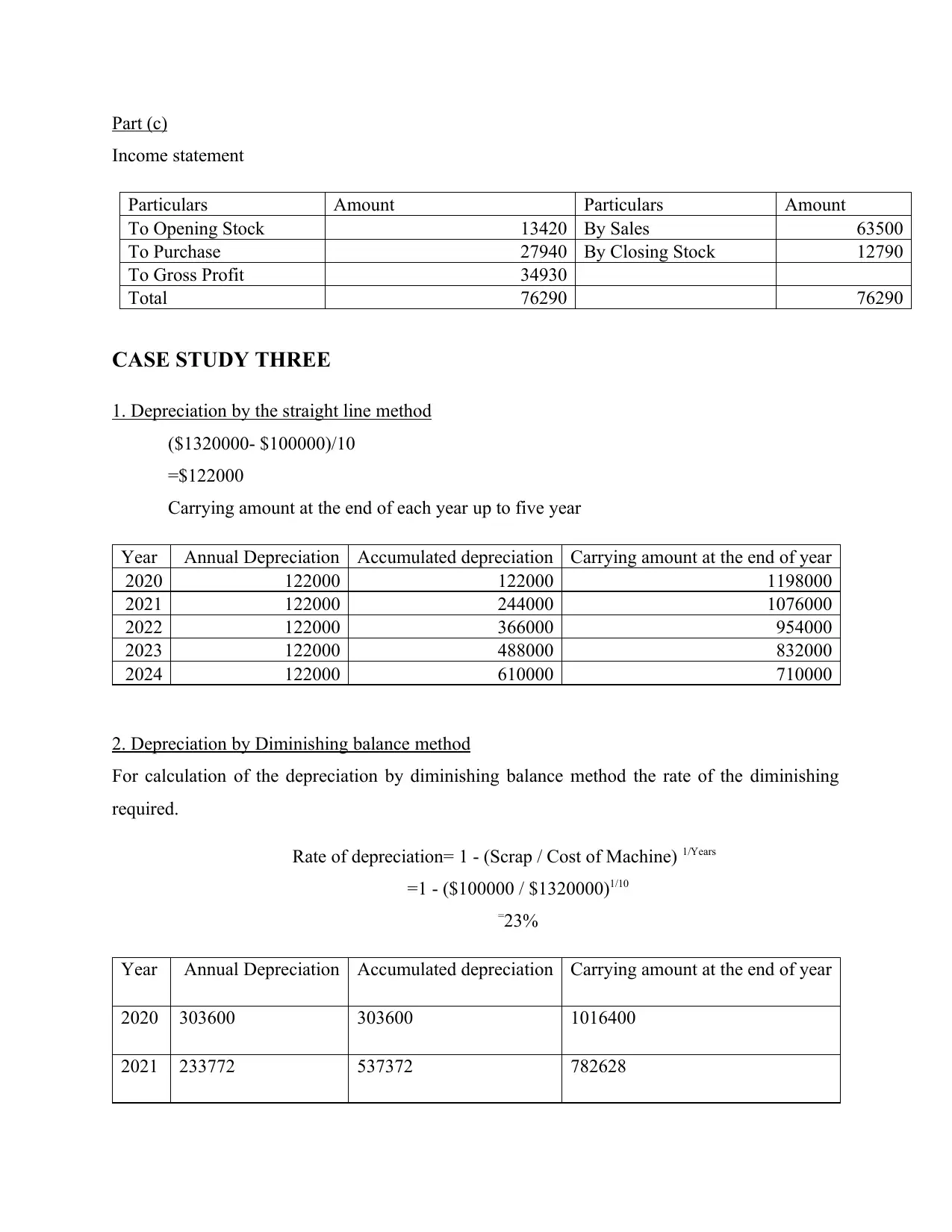
Part (c)
Income statement
Particulars Amount Particulars Amount
To Opening Stock 13420 By Sales 63500
To Purchase 27940 By Closing Stock 12790
To Gross Profit 34930
Total 76290 76290
CASE STUDY THREE
1. Depreciation by the straight line method
($1320000- $100000)/10
=$122000
Carrying amount at the end of each year up to five year
Year Annual Depreciation Accumulated depreciation Carrying amount at the end of year
2020 122000 122000 1198000
2021 122000 244000 1076000
2022 122000 366000 954000
2023 122000 488000 832000
2024 122000 610000 710000
2. Depreciation by Diminishing balance method
For calculation of the depreciation by diminishing balance method the rate of the diminishing
required.
Rate of depreciation= 1 - (Scrap / Cost of Machine) 1/Years
=1 - ($100000 / $1320000)1/10
=23%
Year Annual Depreciation Accumulated depreciation Carrying amount at the end of year
2020 303600 303600 1016400
2021 233772 537372 782628
Income statement
Particulars Amount Particulars Amount
To Opening Stock 13420 By Sales 63500
To Purchase 27940 By Closing Stock 12790
To Gross Profit 34930
Total 76290 76290
CASE STUDY THREE
1. Depreciation by the straight line method
($1320000- $100000)/10
=$122000
Carrying amount at the end of each year up to five year
Year Annual Depreciation Accumulated depreciation Carrying amount at the end of year
2020 122000 122000 1198000
2021 122000 244000 1076000
2022 122000 366000 954000
2023 122000 488000 832000
2024 122000 610000 710000
2. Depreciation by Diminishing balance method
For calculation of the depreciation by diminishing balance method the rate of the diminishing
required.
Rate of depreciation= 1 - (Scrap / Cost of Machine) 1/Years
=1 - ($100000 / $1320000)1/10
=23%
Year Annual Depreciation Accumulated depreciation Carrying amount at the end of year
2020 303600 303600 1016400
2021 233772 537372 782628

2022 180004.4 717376.4 602623.6
2023 138603.4 855979.9 464020.1
2024 106724.6 962704.5 357295.5
3. Deprecation by the sum of year digit method
Calculation of the sum of year digit= 10+9+8+7+6+5+4+3+2+1
=55
Calculation of the depreciable amount= ($1320000-$100000)
=$1220000
Calculation of un depreciable useful life
2020 10
2021 9
2022 8
2023 7
2021 6
Calculation of the Depreciation = Depreciable amount* un depreciable useful life/Sum
of year digit
Year Annual Depreciation Accumulated depreciation Carrying amount at the end of year
2020 221818.2 221818.2 1098182
2021 199636.4 421454.5 898545.5
2022 177454.5 598909.1 721090.9
2023 155272.7 754181.8 565818.2
2024 133090.9 887272.7 432727.3
4. Depreciation by units of production
Cost of the Machine= $ 1320000
The salvage value of the Machine= $100000
2023 138603.4 855979.9 464020.1
2024 106724.6 962704.5 357295.5
3. Deprecation by the sum of year digit method
Calculation of the sum of year digit= 10+9+8+7+6+5+4+3+2+1
=55
Calculation of the depreciable amount= ($1320000-$100000)
=$1220000
Calculation of un depreciable useful life
2020 10
2021 9
2022 8
2023 7
2021 6
Calculation of the Depreciation = Depreciable amount* un depreciable useful life/Sum
of year digit
Year Annual Depreciation Accumulated depreciation Carrying amount at the end of year
2020 221818.2 221818.2 1098182
2021 199636.4 421454.5 898545.5
2022 177454.5 598909.1 721090.9
2023 155272.7 754181.8 565818.2
2024 133090.9 887272.7 432727.3
4. Depreciation by units of production
Cost of the Machine= $ 1320000
The salvage value of the Machine= $100000
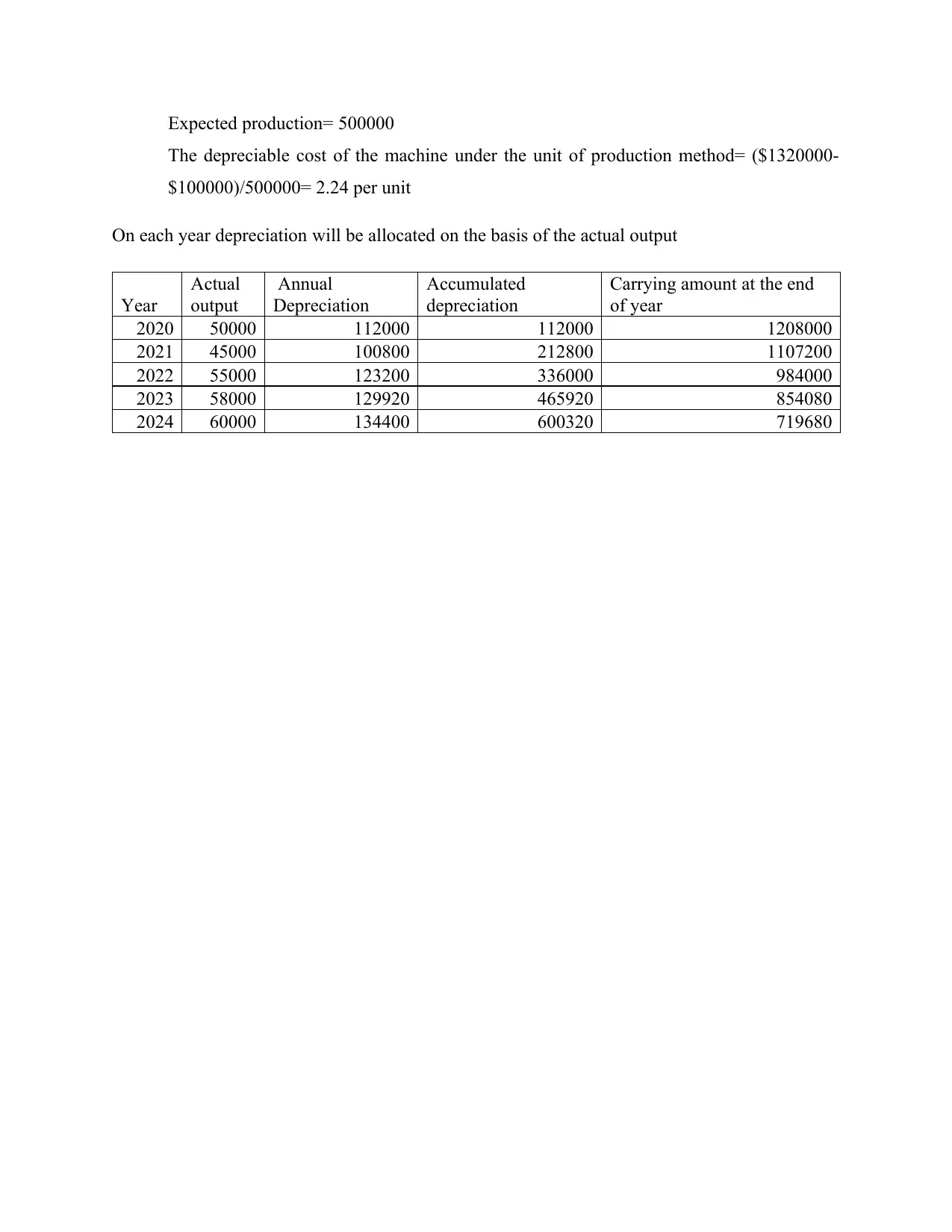
Expected production= 500000
The depreciable cost of the machine under the unit of production method= ($1320000-
$100000)/500000= 2.24 per unit
On each year depreciation will be allocated on the basis of the actual output
Year
Actual
output
Annual
Depreciation
Accumulated
depreciation
Carrying amount at the end
of year
2020 50000 112000 112000 1208000
2021 45000 100800 212800 1107200
2022 55000 123200 336000 984000
2023 58000 129920 465920 854080
2024 60000 134400 600320 719680
The depreciable cost of the machine under the unit of production method= ($1320000-
$100000)/500000= 2.24 per unit
On each year depreciation will be allocated on the basis of the actual output
Year
Actual
output
Annual
Depreciation
Accumulated
depreciation
Carrying amount at the end
of year
2020 50000 112000 112000 1208000
2021 45000 100800 212800 1107200
2022 55000 123200 336000 984000
2023 58000 129920 465920 854080
2024 60000 134400 600320 719680
Secure Best Marks with AI Grader
Need help grading? Try our AI Grader for instant feedback on your assignments.
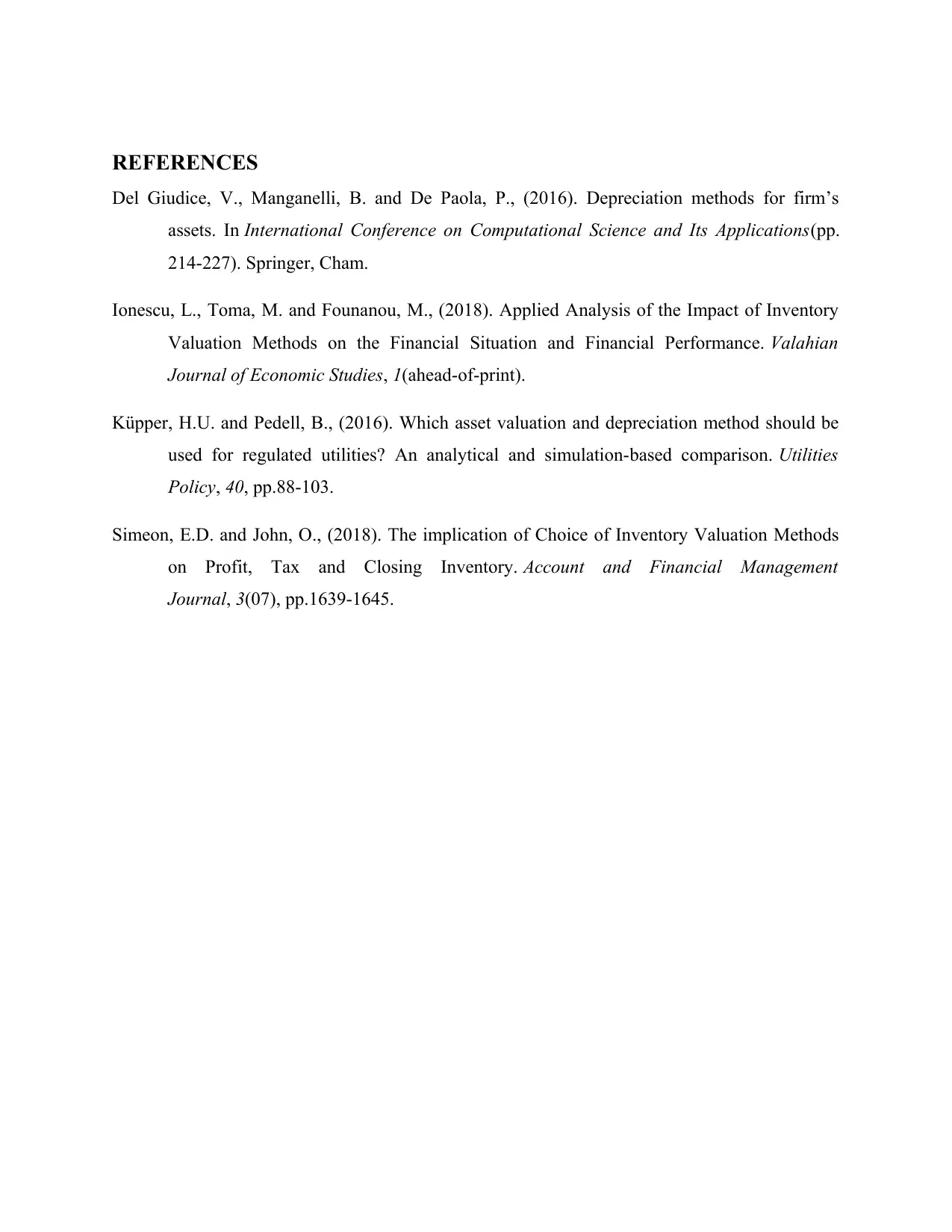
REFERENCES
Del Giudice, V., Manganelli, B. and De Paola, P., (2016). Depreciation methods for firm’s
assets. In International Conference on Computational Science and Its Applications(pp.
214-227). Springer, Cham.
Ionescu, L., Toma, M. and Founanou, M., (2018). Applied Analysis of the Impact of Inventory
Valuation Methods on the Financial Situation and Financial Performance. Valahian
Journal of Economic Studies, 1(ahead-of-print).
Küpper, H.U. and Pedell, B., (2016). Which asset valuation and depreciation method should be
used for regulated utilities? An analytical and simulation-based comparison. Utilities
Policy, 40, pp.88-103.
Simeon, E.D. and John, O., (2018). The implication of Choice of Inventory Valuation Methods
on Profit, Tax and Closing Inventory. Account and Financial Management
Journal, 3(07), pp.1639-1645.
Del Giudice, V., Manganelli, B. and De Paola, P., (2016). Depreciation methods for firm’s
assets. In International Conference on Computational Science and Its Applications(pp.
214-227). Springer, Cham.
Ionescu, L., Toma, M. and Founanou, M., (2018). Applied Analysis of the Impact of Inventory
Valuation Methods on the Financial Situation and Financial Performance. Valahian
Journal of Economic Studies, 1(ahead-of-print).
Küpper, H.U. and Pedell, B., (2016). Which asset valuation and depreciation method should be
used for regulated utilities? An analytical and simulation-based comparison. Utilities
Policy, 40, pp.88-103.
Simeon, E.D. and John, O., (2018). The implication of Choice of Inventory Valuation Methods
on Profit, Tax and Closing Inventory. Account and Financial Management
Journal, 3(07), pp.1639-1645.
1 out of 11
Related Documents
Your All-in-One AI-Powered Toolkit for Academic Success.
+13062052269
info@desklib.com
Available 24*7 on WhatsApp / Email
![[object Object]](/_next/static/media/star-bottom.7253800d.svg)
Unlock your academic potential
© 2024 | Zucol Services PVT LTD | All rights reserved.





